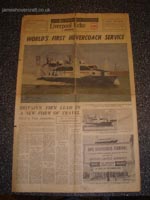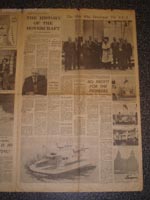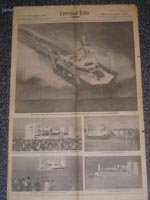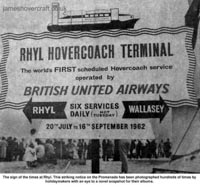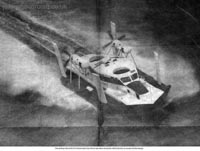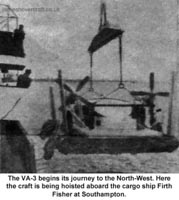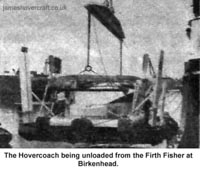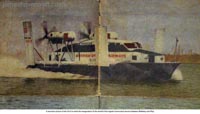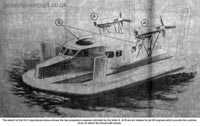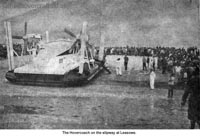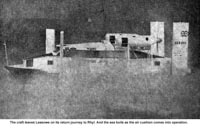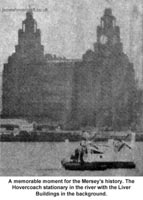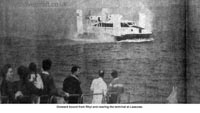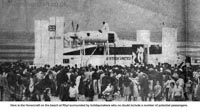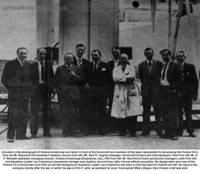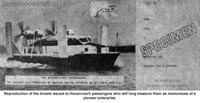LIVERPOOL ECHO HOVERCRAFT SUPPLEMENT: Special Four-Page Souvenir of the Vickers VA-3
Many thanks to Paul Greening who sent this fascinating snippet from the aforementioned newspaper article. The text from the complete articles is below, for ease of reading.
Articles contained and full-text accessible on this page:
BRITAIN'S FIRM LEAD IN A NEW FORM OF TRAVEL
VA-3 A True Amphibian
BY A SPECIAL CORRESPONDENT
The Vickers VA-3 hovercoach, which is this week making transport history, is one way of showing the world that in a very short space of time Britain has established a commanding lead in this revolutionary form of transport.
Since the first hovercraft swept across Southampton Water in a flurry of spray only three years back, the hovercraft has become a household word - even if at this stage the designers are still to an extent in the early research period.
Employing the ground effect air-cushion principle, the hovercraft is completely free from surface contact and is, therefore, truly amphibious.
It needs no airfields, ports or prepared berthing facilities, and, with a flexible speed range of 30 to 100 knots, fills the gap that exists between present forms of transport.
These characteristics fit it ideally for use as an over-water passenger goods carrier operating from land terminals, or for use in areas at present inaccessible to other forms of transport.
New Field of Problems
But these very characteristics which make the most appeal are the ones which have presenter designers with a new field of problems to overcome.
The hovercraft ground-clearance performance has not the clear cut finality of aircraft performance and there is a direct interchange between all-up weight and hover height over a range of values.
An analogous limitation, however, does apply in the ability, or otherwise, of the hovercraft to clear waves of a given height. Operation in partial contact with water gives an increased fuel consumption and a reduced radius of operation.
In the development of the hovercraft, control of weight has therefore been carefully considered balanced against the desire for low production ends.
The structure has been considered on a minimum weight basis compatible with the use of established manufacturing facilities. Where material sizes have been designed by the strength required, aircraft stressing practice has been used.
Craft Weighing Ten Tons
In the absence of recognised acceptance standards, the design materials and components used in the hovercraft have been specified by Vickers-Armstrong (South Marston) Ltd., based on many years of experience of aircraft strength and safety requirements, suitably modified and have due regard to the intrinsic safety of the vehicle.
At a very early stage in the development of hovercraft at Vickers-Armstrong's it was decided that a ten-ton craft was the smallest size to provide useful information on operating capabilities. The initial purpose of the craft was to provide research information in the design field.
So the VA-3 came into being and, to-day, after three months' testing Vickers say they are "happy with it."
The VA-3, which has a surface clearance (hover height) of eight inches was developed for operations at a cruising speed of 60 knots with a pay-load of approximately two tons.
The main hull structure comprises a buoyancy tank and ducting system with a bow to wave impact. Combined, these form a load-carrying platform supporting the power units and superstructure. The construction is mainly of aluminium alloy, which reduces the weight to an absolute minimum.
The buoyancy tank, situated low in the structure, is designed to support a weight of twice the fully-loaded craft, besides giving adequate stability in rough weather.
Additional buoyancy is provided by sealed compartments in the side walls and round the fore and aft transverse air ducts. In the event of total lift power failure, the VA-3 will settle on the water as the air cushion gradually decays.
Rear Facing Seats
The basic platform of the hovercraft comprises a series of watertight compartments to provide a 100 per cent buoyancy reserve which enable it to proceed as a normal displacement vessel.
The standard hovercraft, when used as a passenger vehicle, has accommodation for 24 passengers and a crew of two. The passenger cabin is equipped with rearward facing triple-unit seats, similar to those fitted in aircraft. They are fitted with arm rests and upholstered in silver grey and Devon red.
Easy access is given by two large waterproof doors, insulation is provided by double glazed windows and sound proofed walls and roof, while heating and ventilation equipment is fitted as standard. There is also space provided for toilet and luggage stowage.
For survey, exploration or patrol, the craft can be fitted with a cargo area and could then carry some 4,000lbs of equipment and crew for 80 nautical miles at high speed.
All Round Visibility
The crew cabin is equipped with large windows for all-round visibility and the side windows can be opened - a door behind the second crew members seat links the crew and passenger cabins.
Although Blackburn Turmo-turbine engines are specified for both the lift fans and propulsion drives, the design is sufficiently flexible to allow the use of alternative power units. Two variable pitch, four-bladed propellers are used for the propulsion system.
This pitch-change arrangement extends to reverse thrust, which is used for braking the craft and as an aid to manoeuvrability.
The fuel tank is a single unit integral with the main bulkhead, and is divided to make two compartments. Gravity refuelling is provided.
The electrical system is 28 volt d.c., powered from generators, either of which can, in an emergency, supply full demands. Installations are provided for engine starting and services, fire prevention, navigation and bad weather facilities, lighting for passenger and crew cabins.
Navigational Safety Aids
Navigational safety is ensured by constant VHF communication with shore-based stations at Rhyl and Hoylake, and by the fitment of Decca Navigator (Marine Equipment) system which will provide constant and immediate information on the exact position of the craft, regardless of weather conditions.
Normal marine navigation lighting is supplemented by an amber flashing warning beacon, which will identify the craft to other vessels as a hovercraft.
Designed primarily for coastal operations, the VA-3 has been planned to serve a three-fold purpose:
1. To obtain operating data of value in the design of larger craft.
2. With its capacity of 24 passengers, or just over two tons payload, to provide a machine which can fulfil a useful commercial function.
3. To evaluate the use of surface effect machines to demonstrate their practicability, and to exhibit the speed-with-safety factors of these vehicles in public service.
The VA-3 is proof that the engineering problems associated with this form of transport are being solved, and the fact that hovercraft may have great impact in the next five to ten years, first in meeting the growing demands of the tourist market and then by adding a stimulus to international travel and trade.
THE HISTORY OF THE HOVERCRAFT
By A Special Correspondent
The story of the development of the hovercraft starts from the day 12 years ago when Mr. C. S. Cockerell decided to pack up his job as a radio development engineer with Marconi's and set up a boatyard in Suffolk.
Cockerell went into the boat-building business with immense enthusiasm. But that was not all. He brought with him into the business, in addition to a colossal capacity for work, some ideas which swiftly attracted top-level attention to his modest boatyard.
Cockerell's interest was centred on hull design. But where other designers were concerned with what could be seen above the waterline, the man from Marconi's was soon absorbed in the problems of design affecting the resistance set up between hull and water.
ON SECRET LIST
It became Cockerell's quest to cut down this resistance to its minimum. Soon he was far advanced in the complexities of low-resistance hulls. His solution - and it seemed an incredibly simple one, as with most classic inventions - was that a film of air between the water and the underside of the hull would be the most effective way of cutting out drag.
The problem was how to contain this cushion of air. Cockerell pressed on with his experiments. And right from the start the principle seemed to be successful.
The first model he produced was encouragingly successful. He built more - and demonstrated them to the Ministry of Supply.
In less than five years from setting up his yard, Cockerell's theories seemed proved. Clearly a revolutionary new transport form had been born.
RESISTANCE POSER
Because of the military possibilities of Cockerell's new craft, his project was put on the secret list by the Ministry in 1956. In 1957 a research programme was set up. And a year later the National Research Development Corporation, a Government-sponsored body, took over hovercraft development and the project was declassified.
The problem Cockerell set out to overcome was that of wave resistance, a pressure which acts perpendicular to the hull of the ship and which increases with the speed of the craft.
Marine designers concerned with the development of large ocean linters have consistently run up against a speed barrier which seems to grip a vessel at about 30 knots.
At such speeds wave making resistance tremendously increases the power required to propel the vessel - to the stage at which it becomes too expensive to overcome it by conventional means.
The principle on which the Hovercraft works is the provision of a means of maintaining a nearly uniform pressure on the surface of the sea beneath the craft of a relatively low magnitude and independent of speed. This is done by means of a simple curtain of air around the underside perimeter of the craft.
The jet engine produces air pressures beneath the craft which then forces the curtain outwards to provide a retentive seal for the air cushion.
The results of all this behind-the-scenes activity were first unveiled for the public in June, 1959, in the shape of the SR-N.1, a Saunders-Roe development. A few weeks later the SR-N.1 set off in a cloud of spray on a successful cross-Channel trip from Calais to Dover.
The SR-N.1 was the first full-scale amphibious test craft. It behaved well in different sea conditions. And it carried out many successful beaching operations on gradients of up to one in ten.
Stimulated by these early successes, Hovercraft Development Limited went ahead. Companies to the fore in aircraft, helicopter and rivercraft development became associates of H. D. L. to form a central body for research and development.
The Vickers-Armstrong VA-1 became operational in 1960. At a weight of 4,600lb, it can now achieve a hoverheight of five inches and a maximum speed in excess of 30 knots.
William Denny and Bros., Ltd., the Scottish ship-builders, completed successful trials of their D1 hovercraft. This was the first in this country to employ the side wall technique of air cushion retention.
The research programme of Folland Aircraft quickly produced the idea of the GERM (ground effect research machine). This has yielded much valuable information on the kind of systems to be incorporated in such early commercial vehicles as the "Hovertruck".
A vehicle 18ft long, 8ft wide and carrying a crew of two, can be raised and propelled by two motor-cycle engines of 700 c.c. capacity each.
The rapid development of Cockerell's principle has been as dramatic in its way as Whittle's discovery of the principles of the jet engine.
There are countless possible applications of the hovercraft idea. At one end of the scale are the little hover-abouts run by a couple of motor-cycle engines. At the other end are the ocean-going giants of 1,000 tons.
This is one of the most exciting stories of this modern age. And that is why the eyes of the world will be on the world's first hovercraft service across the mouth of the Dee estuary this week-end.
NO PROFIT FOR THE PIONEERS
Purely An Experiment
BY "ECHO" REPORTER
To British United Airways, the operators, the Wallasey-Rhyl service is regarded as "an experiment in commercial operation".
Even if the honour of starting the world's first-ever scheduled hovercraft service belongs undeniably to them, they are still not likely to show a profit on it.
B.U.A. settle don the Rhyl-Wallasey route because it is over terrain unsuitable for other transport. No conventional vehicles can regularly cross the sands and tidal waters of the Dee estuary.
Rhyl is also a good tourist area which a large source of potential "customers" for the first-ever ride during the summer months.
The airline has already taken over 5,000 advance bookings out of a maximum possible total of 14,000 for the period but the venture will not show a profit.
Mr. F. A. Laker, managing director of B.U.A., has commented that the objects of this experiment are three-fold:
1--To get an idea of the problems involved in an entirely new form of transport.
2--To find out how the public reacts to hovercraft travel.
3--To try and determine what sort of craft will be required for future commercial operation.
Bluntly, he has added: "We are not expecting to make any money out of this trial service." That is the price the line are paying for the chance to participate at an early stage in an experiment which may lead to a great future for hovercraft operations.
B.U.A. have already played a prominent part in the history of civil aviation. They are one of the group of companies owned by Air Holdings, Ltd., among whose shareholders are such major shipping companies as Blue Star Line, British and Commonwealth, Furness Withy, and the P. and O.
Air Holdings was formed at the end of 1961 as a step towards rationalisation within the group and holds not only the share capital of B.U.A. but also that of the other companies formerly owned by B.U.A.
B.U.A. came into being under this name in July, 1960, following the amalgamation into the Airwork group of Hunting-Clan. It includes such former well-established companies as Airwork, Air Charter, Hunting-Clan, Morton, Olley and Transiar, with a history dating back to 1928.
In that year Airwork bought land at Heston and built one of London's original airports. For two decades Airwork owned and operated the airport, which, during the thirties, was one of Europe's principal civil aviation centres.
SAFARI SERVICES
B.U.A. operate scheduled passenger services from Gawick Airport to East, West and Central Africa (the Safari services), to the Canary Isles, Gibraltar, Malaga, Rotterdam and the Channel Islands.
In addition they run regular contract services carrying Service personnel and their families to four destinations in Germany, and to Honk Kong, Singapore, Aden, Nairobi and Cyprus, holidaymakers to numerous European and other resorts, and large-scale freight operations.
The line also act as technical adviser to Sudan Airways (and operate its Blue Nile Viscount services between Africa and Europe) and manage Sierra Leone Airways.
The are closely associated with the other air transport companies in the Air Holdings Group - among them Airwork International; Morton Air Services; Channel Air Bridge; Silver City Airways; Jersey Airlines, and Straits Air Freight Express.
The combined airline fleets of the group number over 100 aircraft, including Britannias, Viscounts, DC6's, jet-prop Heralds and the Carvairs and Bristol 170's of the Channel Air Bridge and Silver City.
On order are four jet V. C. 10's and B.A.C. One-eleven twin jets, worth about £20,000,000, and ten more Carvairs.
Last year, nearly 2,000,000 passengers, over 95,000 tons of freight and nearly 120,000 vehicles were carried. The group employees total over 5,000.

